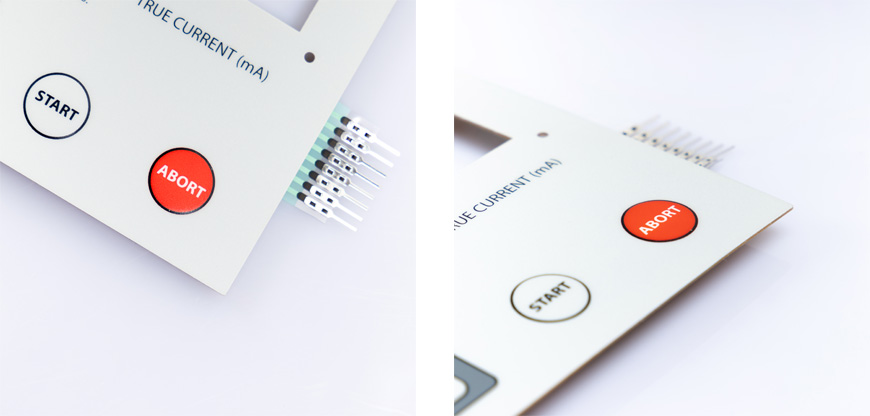
In today's fast-paced world, technology surrounds us everywhere we go. From smartphones to kitchen appliances, we interact with devices daily. Have you ever wondered how these devices respond to your touch or input? That's where membrane switches with LED come into play. In this comprehensive guide, we will delve into the world of membrane switches, shedding light on how they work, their applications, benefits, and more.

A membrane switch is a type of electrical switch that consists of multiple layers, including a conductive circuit, a graphic overlay, and a spacer layer. These layers come together to create an interface for the user to interact with electronics. The simplicity of the design and the ability to customize makes membrane switches a preferred choice for many industries.
In a membrane switch, when pressure is applied to a specific key or button, the top layer (graphic overlay) compresses and makes contact with the conductive layer beneath, which completes the circuit and activates the function. When pressure is released, the switch returns to its original state.
The addition of LED (Light Emitting Diode) lighting within membrane switches enhances visibility, improves usability, and adds an element of aesthetic design. The LED lights are typically placed beneath the graphic overlay, which helps illuminate the keys for better visibility, especially in low-light environments.
Graphic Overlay: The top layer that users interact with, often featuring printed symbols or text.
Membrane: A flexible layer with conductive traces.
Spacer: Separates the upper and lower circuits, ensuring a response when pressed.
Bottom Circuit Layer: Contains the conductive contacts that register the input.
The working principle of a membrane switch is simple yet highly effective. When pressure is applied to a specific key or area on the switch, the layers compress and create a conductive path between the contacts of the circuit layer, allowing electricity to flow. This completes the circuit and activates the corresponding function.
The inclusion of LED lighting adds a visual aspect to the switch's operation. The LED lights beneath the graphic overlay illuminate the switch, making it easier to see and operate in low-light or dark environments. This makes membrane switches with LED lighting ideal for devices used in night-time settings or for applications that require clear visibility.
Membrane switches can also be designed with varying levels of feedback to accommodate user preferences, offering either tactile or non-tactile responses. When combined with LED backlighting, these switches not only serve their functional role but also enhance the overall aesthetic and user experience.
Membrane switches combined with LED technology offer several advantages:
Durability: They are highly resistant to wear and tear.
Customizable: LED backlighting can be tailored to specific requirements.
Tactile Feedback: Membrane switches provide tactile feedback to users.
Cost-Efficiency: They are cost-effective for both small and large-scale production.
Compact Design: Ideal for applications with limited space.
In medical equipment, membrane switches with LED lighting are commonly used in control panels of devices like patient monitors, diagnostic machines, and portable medical devices. The LED backlighting enhances visibility, making it easier for healthcare professionals to operate the equipment in low-light settings. The ability to customize the switches with intuitive designs and labels also ensures seamless interaction.
Membrane switches with LED lighting are commonly found in automotive applications such as dashboard controls, climate control systems, and infotainment systems. The LED lights improve visibility, especially for controls in dark or nighttime driving conditions, while the membrane switch technology offers a durable and sleek solution that fits well into modern vehicle interiors.
Membrane switches with LED backlighting are often used in consumer electronics such as TV remote controls, microwave ovens, and home appliances. The LED lighting provides clear visibility of the buttons, making them easier to use in dimly lit environments. Membrane switches allow for low-profile designs, making them ideal for compact devices.
Membrane switches are extensively used in industrial equipment for machinery control panels, HVAC systems, and other devices that require high durability and ease of use. The LED lighting enhances the visibility of control buttons, which is especially beneficial in manufacturing environments or places with poor lighting conditions. The ability to customize the layout and design ensures the switches align with the functional needs of the equipment.
Surface Preparation: Before applying the membrane switch, ensure that the surface is clean, dry, and free of dust or oils. This ensures that the adhesive layer bonds properly.
Correct Positioning: Carefully position the membrane switch over the device's surface to avoid misalignment. Take extra care in aligning the keypads or buttons with the circuit components to prevent functionality issues.
Adhere to Manufacturer Guidelines: Always follow the manufacturer's installation instructions to ensure proper placement and functionality.
Cleaning: Membrane switches with LED lighting are easy to clean. Use a soft cloth or microfiber towel with mild cleaners or a damp cloth. Avoid using harsh chemicals or abrasive materials that may damage the surface or LED components.
Check for Wear: Regularly inspect the switch for signs of wear or damage, particularly around the edges or where pressure is applied frequently. If the switch starts to lose its tactile feel or the LED lights dim, it may need servicing or replacement.
Environmental Protection: Ensure that the membrane switch is installed in an environment that protects it from excessive heat, moisture, and dust, which could damage both the LED lighting and the conductive traces.
Q: Are membrane switches waterproof?
A: Yes, membrane switches can be designed to be waterproof, making them suitable for outdoor and harsh environments.
Q: Can LED colors be changed on membrane switches?
A: Yes, the LED colors on membrane switches are customizable to match the design and functionality requirements.
Q: Are membrane switches easy to clean?
A: Membrane switches are easy to clean and maintain, making them ideal for applications with hygiene concerns.
Q: Do membrane switches have a long lifespan?
A: Membrane switches are known for their durability and can last for millions of cycles, depending on the quality and usage.
Q: Can membrane switches be used in extreme temperatures?
A: Membrane switches can be designed to withstand extreme temperatures, making them suitable for a wide range of environments.